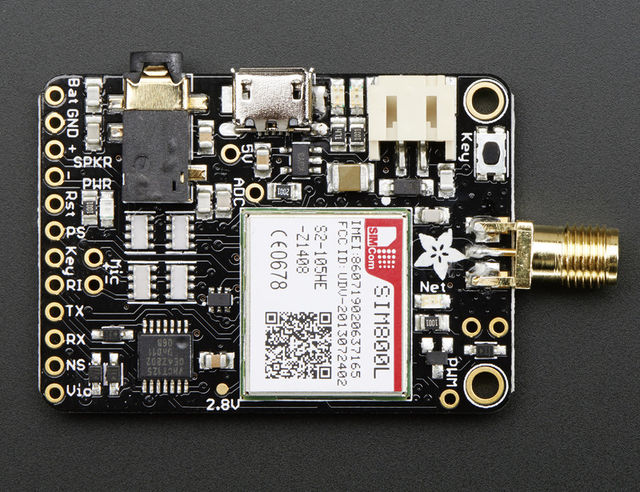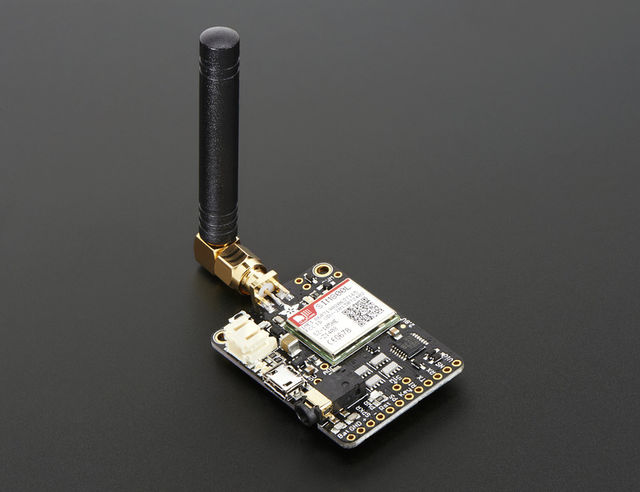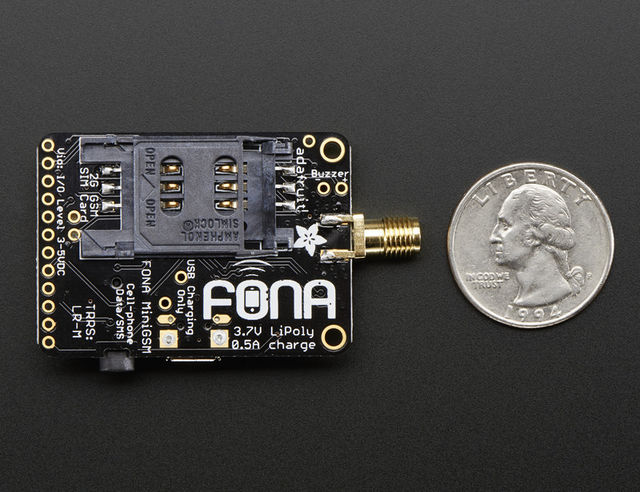Différences entre versions de « ADAFRUIT-FONA-Pinout »
| Ligne 48 : | Ligne 48 : | ||
* '''NS''' - c'est la broche '''N'''etwork '''S'''tatus (''Status réseau''). Cette broche envoi des impulsions correspondant au statut actuel du module. Cette broche est branchée sur la LED '''Net''' (voyez la section LED ci-dessous pour plus d'information). | * '''NS''' - c'est la broche '''N'''etwork '''S'''tatus (''Status réseau''). Cette broche envoi des impulsions correspondant au statut actuel du module. Cette broche est branchée sur la LED '''Net''' (voyez la section LED ci-dessous pour plus d'information). | ||
* '''Reset''' - C'est la broche de réinitialisation matériel du module (dit "Hard Reset"). Ce n'est pas une réinitialisation logicielle. Par défaut, cette broche est maintenu au niveau Haut à l'aide d'une résistance pull-up (donc, le module n'est pas réinitialisé). Si vous n'arrivez vraiment plus à contrôler votre module, placez ce signal au niveau bas pendant au moins 100ms pour faire un réinitialisation métériel. | * '''Reset''' - C'est la broche de réinitialisation matériel du module (dit "Hard Reset"). Ce n'est pas une réinitialisation logicielle. Par défaut, cette broche est maintenu au niveau Haut à l'aide d'une résistance pull-up (donc, le module n'est pas réinitialisé). Si vous n'arrivez vraiment plus à contrôler votre module, placez ce signal au niveau bas pendant au moins 100ms pour faire un réinitialisation métériel. | ||
| − | * '''RX & TX''' - | + | * '''RX & TX''' - Le module utilise un UART (port série) pour envoyer et recevoir des commandes et des données. Ces broches disposent d'une détection "auto-baud", donc peut importe la vitesse à laquelle vous envoyez vos commandes "AT" après un Reset ou boot/démarrage deviendra la vitesse utilisée par le module. Le signal '''RX''' rentre dans le module, tandis que le signal '''TX''' sort du module.<br />Note importante: Lors de nos tests avec Arduino (voir plus loin), nous avons remarqué qu'il était important d'utilise CR + LF comme terminateur de commande (CR + LF = Carriage Return + Line Feed). |
* '''RI''' - Il s'agit du signal '''R'''ing '''I'''ndicator (''Indicateur de sonnerie''). It is basically the 'interrupt' out pin from the module. It is by default high and will pulse low for 120ms when a call is received. It can also be configured to pulse when an SMS is received. | * '''RI''' - Il s'agit du signal '''R'''ing '''I'''ndicator (''Indicateur de sonnerie''). It is basically the 'interrupt' out pin from the module. It is by default high and will pulse low for 120ms when a call is received. It can also be configured to pulse when an SMS is received. | ||
* '''SPK+''' et '''SPK-''' : This is for connecting an external 8 ohm speaker, max 1W. You can configure the module to route calls and FM radio to the headset or the external audio. The two pins are differential so they don't have output DC blocking capacitors. <font color="red">'''You cannot connect this to a stereo, powered speakers or other non-differential amplifier'''</font> without adding a 100uF+ blocking cap in series to the + pin and then not using the - pin. Instead, your amp should use GND for the - reference | * '''SPK+''' et '''SPK-''' : This is for connecting an external 8 ohm speaker, max 1W. You can configure the module to route calls and FM radio to the headset or the external audio. The two pins are differential so they don't have output DC blocking capacitors. <font color="red">'''You cannot connect this to a stereo, powered speakers or other non-differential amplifier'''</font> without adding a 100uF+ blocking cap in series to the + pin and then not using the - pin. Instead, your amp should use GND for the - reference | ||
Version du 7 novembre 2015 à 14:10
Vue d'ensemble
Il y a beaucoup de composants assemblés sur la mini carte GSM Fona, Faisons un petit tour de toutes les broches, boutons et indicateurs et apprendre ce qu'ils font.

Crédit: AdaFruit Industries www.adafruit.com
Les connecteurs
Il y a trois connecteurs externe sur le côté gauche de la carte. Du haut en bas, nous avons un connecteur mini-JST 2 pôles, un connecteur microUSB et connecteur casque.
- JST 2-broches - ce connecteur vous permet de brancher un accu. Il fonctionne avec nos accus Lipoly mais étant donné que le courant de charge est de 500mA (et que le module peut générer d'importante pointes d'appel de courant), nous recommande d'utiliser des accu de 500mAh ou 1200mAh. Vous pouvez également connecter un câble JST sur ce connecteur si vous avez d'autres plans.
- Connecteur MicroUSB - C'est le port permettant de recharger l'accu LiPoly/LiIon. Le SIM800 dispose d'une interface USB mais c'est UNIQUEMENT pour reprogrammer le module avec un environnement de programmation (non disponible et vraiment couteux). Par consquent, il est uniquement destiné à recharger l'accu Lipoly. Le courant de charge est de 500mA max.
- Connecteur casque - dit headphone jack, il s'agit d'un connecteur 'standard' TRRS de 3.5mm (4 poles) avec casque stéréo et microphone mono. N'import quel casque compatible 'iPhone' ou 'Android' devrait fonctionner (mais pas le casque original iPhone!). Adafruit à essayé une dizaine de module, d'une façon générale, plus il est coûteux et meilleur est le rendu sonore (ainsi que le comfort) mais pour une raison inconnue, le micro du casque iPhone officiel ne fonctionne pas.
La base est Mic+, le premier anneau la masse/GND, le second anneau et la pointe sont utilisés pour le signal audio stéréo.
Comme le module ne dispose pas de sortie stéréo, les deux signaux stéréo sont reliés ensembles.

Crédit: AdaFruit Industries www.adafruit.com
Connecteur d'Antenne
Vous pouvez brancher l'antenne sur le dessus de la carte (soit sur le connecteur SMA comme sur l'image, soit sur le connecteur µFL suivant la version de votre Fona).
Une antenne est nécessaire pour utiliser ce module pour n'importe quel type de communication (voie, donnée, SMS, même pour intérroger la carte SIM!).
Il existe deux version du Fona: le Fona SMA et le Fona µFL. Vous pouvez soit utiliser une µFL antenne GSM de type sticker, ou utiliser un adaptateur µFL vers SMA et ensuite utiliser une Antenne SMA GSM standard
Si vous disposez de la version SMA, vous pouvez connecter directement une SMA antenna. Nous recommandons l'usage d'une antenne GSM/GPRS Quad band, mais vous pouvez également utiliser une antenne simple ou double bande si vous êtes certains de la gamme de fréquence disponibles dans votre région (assurez-vous d'avoir l'antenne qui corresponde à la gamme de fréquence en vigueur).

Crédit: AdaFruit Industries www.adafruit.com
Connecteur SIM (à l'arrière)
Une carte SIM GSM (format SIM Mini, 2G) et nécessaire pour utiliser ce module. Presque tout les vendeur de téléphone portable peuvent vous vendre une telle carte SIM. Cela doit être une carte GSM 2G.
En Belgique, nous avons utilisé une carte de l'opérateur "Mobistar", no clients français ne semblent pas avoir de problèmes sur leur territoire (par défaut de retour client).
Attention, une carte MicroSIM ne tiendra pas dans le réceptable pour carte SIM. Les cartes Mini SIM font 25mm x 15mm, ce qui est de loin le format le plus répandu.
La plupart des cartes inclus un plan voix/SMS and/ou DATA. Si vous désirez faire des appels téléphoniques et envoyer des SMS, vous aurez besoin d'un plan "Voix". Si vous désirez envoyer des données ou récupérer des informations depuis une page web alors vous aurez besoin d'un plan "de donnée" (communément dit "DATA").
Les breakouts (en bas)
Les broches les plus importantes sont disponibles sur le bas de la carte. Ells ne sont pas toutes nécessaires mais elles sont toutes vraiment utiles.
Ces broches sont principalement ordonnées en fonction de leur importance (pas dans un ordre linéaire comme c'est d'abitude le cas).
Ces broches sont toutes des entrées supportant 3-5 volts (dit "3-5v safe") et si elles sont utilisées en sortie le niveau logique est adapté à la tension présente sur la broche Vio.
- Vio - C'EST LA BROCHE LA PLUS IMPORTANTE! C'est la broche que vous DEVEZ piloter avec une tension extérieur de 3V-5V pour initialiser le convertisseur de niveau logique. Le convertisseur est également un tempon pour les LEDs indicatrices... par conséquent RIEN ne fonctionnera à moins d'avoir cette broche alimentée!
Vous devriez appliquer la tension correspondant à la logique de cette de votre microcontrôleur. Un microcontroleur 5V (comme Arduino, Adafruit Metro) devrait avoir une tension Vio=5V, Un microcontrôleur à logique 3V, il faut utiliser une tension Vio=3V. - Key - Il s'agit d'une broche super importante (mais pas aussi importante que Vio). C'est l'indicateur de mise sous-tension/hors-tension (on-off). Cette broche est également raccordée sur le bouton "KEY" en haut à gauche. Branchez cette broche sur la masse (GND) pendant 2 secondes pour allumer ou éteindre le module. Ce n'est pas un "signal logique" et, par conséquent, cela ne se réduit pas à "Niveau Haut = Allumé" et "Niveau Bas = Eteint" - à la place, vous devez donner une impulsion pendant deux secondes pour l'allumer et une autre impulsion pour éteindre. Le module est livré "eteint" par défaut. Raccordez le sur la masse si vous ne désirez pas que votre microcontrôleur éteigne votre Fona afin d'économiser de l'énergie.
- PS - Cette broche correspond à la LED Power Status qui indique si le module est alimenté. Le signal est au niveau bas lorsque le module est éteint et niveau haut lorsque le module est allumé. Si vous utilisez le bouton (ou broche) Key pour contrôler votre Fona, alors vous pouvez savoir si le module est allumé (ou non) en surveillant cette broche (PS: le signal passe au niveau haut qu'après le boot du module... Ce qui nécessite environ 2 secondes). Ce signal est branché sur la LED Pwr.
- NS - c'est la broche Network Status (Status réseau). Cette broche envoi des impulsions correspondant au statut actuel du module. Cette broche est branchée sur la LED Net (voyez la section LED ci-dessous pour plus d'information).
- Reset - C'est la broche de réinitialisation matériel du module (dit "Hard Reset"). Ce n'est pas une réinitialisation logicielle. Par défaut, cette broche est maintenu au niveau Haut à l'aide d'une résistance pull-up (donc, le module n'est pas réinitialisé). Si vous n'arrivez vraiment plus à contrôler votre module, placez ce signal au niveau bas pendant au moins 100ms pour faire un réinitialisation métériel.
- RX & TX - Le module utilise un UART (port série) pour envoyer et recevoir des commandes et des données. Ces broches disposent d'une détection "auto-baud", donc peut importe la vitesse à laquelle vous envoyez vos commandes "AT" après un Reset ou boot/démarrage deviendra la vitesse utilisée par le module. Le signal RX rentre dans le module, tandis que le signal TX sort du module.
Note importante: Lors de nos tests avec Arduino (voir plus loin), nous avons remarqué qu'il était important d'utilise CR + LF comme terminateur de commande (CR + LF = Carriage Return + Line Feed). - RI - Il s'agit du signal Ring Indicator (Indicateur de sonnerie). It is basically the 'interrupt' out pin from the module. It is by default high and will pulse low for 120ms when a call is received. It can also be configured to pulse when an SMS is received.
- SPK+ et SPK- : This is for connecting an external 8 ohm speaker, max 1W. You can configure the module to route calls and FM radio to the headset or the external audio. The two pins are differential so they don't have output DC blocking capacitors. You cannot connect this to a stereo, powered speakers or other non-differential amplifier without adding a 100uF+ blocking cap in series to the + pin and then not using the - pin. Instead, your amp should use GND for the - reference
MIC + et -: this is for connecting an external electret microphone, it will bias the mic with 2V. Most electrets will work just fine. No extra circuitry is required for the mic such as a biaser or amplifier, just wire it up directly!
Les LEDs
- PWR - Blue! Lit when the module is booted and running
- NET - Red! You can use this for checking the current state without sending an AT command:
By watching the blinks you can get a visual feedback on whats going on.- 64ms on, 800ms off - the module is running but hasn't made connection to the cellular network yet
- 64ms on, 3 seconds off - the module has made contact with the cellular network and can send/receive voice and SMS
- 64ms on, 300ms off - the GPRS data connection you requested is active
- Charging - état de rechargement de l'accumulateur Lipo.
- Orange! - This is next to the microUSB jack. Indicates the onboard lipo charger is charging
- Vert! - Recharge terminée! This is next to the JST jack. Indicates that the battery charging is done and the battery is full
Autres breakouts
We scattered a few other breakouts around the board.
- Buzzer and PWM (Top right) - These are tied to the PWM output of the module! The PWM capability is quite nice, it can set any frequency and duty cycle. The PWM pin is directly output from the module and is 0-2.8Vpp. The Buzzer output has a NPN drive transistor so it can run a small vibration motor. Bz+ is the VBat voltage, Bz- is toggled on and off to ground.
- ADC (left middle) - the SIM800 has an ADC that can read 0-2.8VDC from this pin, referenced to ground. It also has an internal battery ADC so you can use this for a sensor or something. You can query the voltage from the UART. 2.8V max, people!
- 5V (left middle) - this is the USB 5V from the microUSB connector when its in and powered. Good if you need to know when the microUSB is plugged in and/or want to recharge the battery from an external plug.
- Point de test 2.8V - We have a test point for the 2.8V internal regulator, its off to the right.
Source: Adafruit FONA - Call phones, send and receive SMSs, & more! All with FONA. Ecrit par Lady Ada pour AdaFruit. Crédit AdaFruit Industries
Traduit par Meurisse D. pour MCHobby.be
Traduit avec l'autorisation d'AdaFruit Industries - Translated with the permission from Adafruit Industries - www.adafruit.com
Toute référence, mention ou extrait de cette traduction doit être explicitement accompagné du texte suivant : « Traduction par MCHobby (www.MCHobby.be) - Vente de kit et composants » avec un lien vers la source (donc cette page) et ce quelque soit le média utilisé.
L'utilisation commercial de la traduction (texte) et/ou réalisation, même partielle, pourrait être soumis à redevance. Dans tous les cas de figures, vous devez également obtenir l'accord du(des) détenteur initial des droits. Celui de MC Hobby s'arrêtant au travail de traduction proprement dit.
